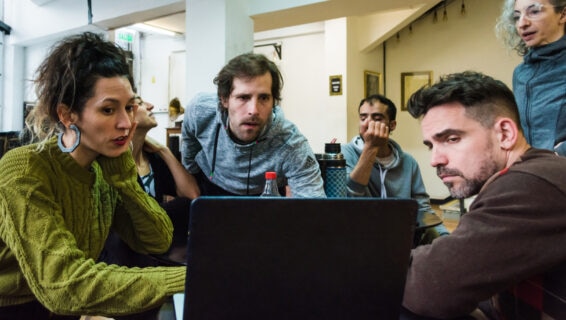
How to evaluate candidates
Table of Contents
- The importance of a evaluation process
- Establishing a unified candidate assessment framework
- Creating a collaborative assessment team environment
- Developing a interview process
- Continuous improvement
Finding top talent can be tough, with the average role taking almost five weeks to fill. That’s why it makes sense to tackle it as a team—after all, many hands make light work. However, without structure, having multiple people involved in the process can bring its own challenges. Whether it’s inconsistency, lingering biases, or maintaining a speedy decision-making process, the end result can often be the same: mismatched hires and missed opportunities to hire the best talent. Thankfully, by implementing a simple process and a clear evaluation framework, you can tackle these issues and improve the candidate experience. In this article, we’ll look at how your team can assess job candidates effectively and ensure fair, consistent evaluations that help improve your quality of hire. Let’s get started.
Understanding the importance of a consistent evaluation process
If you want to make the right hire, you need a reliable approach to assessing candidates’ ability to be successful in the role. Without a solid process in place, evaluating candidates can become messy and subjective—especially when there are multiple people involved. Let’s explore why a consistent process isn’t just helpful, but a necessary part of your hiring strategy.
The risks of an inconsistent screening process
An inconsistent screening process can lead to several issues:
- Unfair assessments: Without having a structure in place, different opinions from your hiring team can lead to inconsistent evaluations. This means you might overlook or dismiss strong candidates by mistake.
- Unconscious bias: With 48% of recruiters and HR managers admitting that their own bias can impact their choices, you need safeguards to prevent this from influencing your team’s decisions.
- Increased turnover rates: With nearly a third of new hires leaving within their first six months, the wrong decision can fuel higher turnover, disrupting team stability and morale.
- Brand damage: An inconsistent approach to recruitment can harm your employer brand, with word-of-mouth and online reviews amplifying any negative experiences.
Benefits of a standardised candidate assessment
A standardised assessment process takes the guesswork out of hiring. By using clear criteria to filter candidates, hiring managers can sidestep any potential biases and provide consistent, fair evaluations for everyone who applies. Beyond transparency and fairness, this helps your team to make quicker, more informed decisions—saving time and reducing back-and-forth. With half of UK workers turning down job offers because the recruitment process took too long, this streamlined approach can also help you keep the candidates selected engaged and increase your chances of securing a great hire.
Establishing a unified candidate assessment framework
A candidate assessment framework is a consistent way of judging candidates across different stages of the hiring process. It aims to set clear criteria to measure each candidates’ skillset, potential skill level, cultural fit and suitability for the role when:
- Shortlisting and filtering
- Interviewing and providing feedback
- Making a job offer
This approach helps ensure evaluations are fair and consistent, no matter who is assessing the candidates or what stage of the process they’re in.
Key components of an effective framework
An effective evaluation framework should include:
- Clear roles: Make sure everyone on the hiring team knows their role in the process and understands their responsibilities and tasks to complete.
- Interview structure: A consistent interview approach with set questions that helps ensure fairness and avoids inconsistency.
- A scoring system: A rating system or scorecard can standardise how you assess each candidate’s skills, experience, and fit for your team.
- Full evaluation form: A dedicated section for feedback on a candidate’s strengths, weaknesses, and overall impressions.
It’s also important to align the framework with your company’s goals and culture, ensuring you hire people who fit in well. Involving different stakeholders will help cover all angles and make your process even more robust.
Developing evaluation criteria for candidates
To find the right candidate, you need to know what you’re looking for. Start by looking at the job description alongside your organisation’s goals. This will give you a solid benchmark for the key skills, personality, and experience someone needs to succeed in the role. You can strengthen this by seeking feedback from management or considering the skills and traits of your top performers. Remember, while technical skills are essential, you can’t overlook soft skills and cultural fit—these are often what make someone a long-term success in the role. An evaluation framework should cover:
- Hard skills: Does the candidate have the technical skills, qualifications, and experience to excel in the role?
- Soft skills: Qualities like communication, problem-solving, and adaptability are crucial for long-term success and should be a priority.
- Cultural fit: How well does the candidate align with your company’s values and team dynamics?
To get the best results, make sure you regularly review and update your evaluation criteria as your business evolves.
Creating a collaborative assessment team environment
When recruiting as a team, you want everyone to be on the same page. Here’s how you can build a cohesive team that makes better hiring decisions.
Roles and responsibilities of interviews
To get the most out of your candidate interviews, everyone on your hiring team should know exactly what’s expected of them. Consider:
- Training and development: Invest time in training your hiring team on how to assess candidates in interviews. Trained interviewers are more likely to ask the right questions and evaluate candidates fairly.
- Specific responsibilities: Whether it’s introducing your organisation, diving into the specifics of the role, or asking structured questions to gauge skills and cultural fit, clearly define what each interviewer will focus on.
- Diverse perspectives: Encourage all team members to ask questions, engage with the candidate, and share their feedback. The more perspectives you get, the better.
- Using the evaluation framework: Have your team complete their assessment of each candidate during or immediately after the interview. This helps avoid their evaluation being informed by other members of the team and helps build a comprehensive view of the candidate.
Establishing clear communication guidelines
To ensure a smooth evaluation process, you need clear guidelines for sharing candidate feedback. In order to achieve this, you can look to implement:
- Structured feedback: Create a system for sharing and discussing feedback based on your evaluation criteria for interview candidates. This keeps everyone’s input organised and easy to understand.
- Regular check-ins: Schedule regular meetings to discuss scores, feedback and overall impressions of each candidate. This helps highlight any differences in opinion early on.
- Shared documentation: Use a shared document or online tool where everyone can record their evaluations and notes. This way, everyone’s on the same page and can contribute to a comprehensive view of each candidate.
Developing a structured interview process
Whether you’re using one interviewer or a full panel, putting a structure in place can make a world of difference. By following a clear framework, you’ll be better placed to compare each candidate, identify the best fit for the role, and make more reliable hiring decisions. Let’s look at the strategies you can implement to put this framework in place.
Crafting standardised interview questions
Sometimes, interviews can naturally slip into conversations. The downside of this is that you run the risk of missing out on important details or are left relying on gut feeling alone. To keep things on track, develop a core set of questions that match the role’s requirements and your evaluation criteria. For interview best practice, the same questions should be asked to every candidate you meet. The added benefit is that these standardised, competency-based questions provide a clearer picture of how candidates handle real-world challenges and fit with your company’s culture.
Utilising assessment tools and techniques
To help you select the best candidates and keep the process fair, here are some useful tools to consider:
- Competency frameworks: Evaluate responses based on the specific skills and qualities needed for the role. You can use simple scoring rubrics to rate candidates on a scale from 1-5.
- Tests and work samples: Get a real sense of a candidate’s technical abilities or job-related skills through practical tasks during interviews or as assigned tasks.
- AI video screening: Quickly analyse candidates’ responses to preset questions, making the early stages of screening more efficient.
For the most accurate and fair results, try to benchmark these tools against industry standards where possible.
Ensuring active listening and note-taking
Active listening and effective note-taking are essential for a successful interview. Here are some tips to get it right:
- Stay focused: Every interviewer should close their laptop or use ‘Do Not Disturb’ mode to avoid distractions and give candidates their full attention.
- Capture key points: Each interviewer should jot down specific details from answers and fill in a scorecard based on your evaluation framework. Keep notes brief to avoid missing important parts of the conversation.
- Review and expand: Right after the interview, review your notes independently to fill in any gaps and ensure nothing important is missed.
Using evaluation for consistency
As we’ve touched upon, a scoring system can really help keep things consistent and reduce bias in candidate assessments. In fact, almost a third of employers have seen improvements in the diversity of their teams by using them. To get started, have each interviewer use a standardised scoring system to evaluate candidates’ skills and how well they fit the role. Then, when it comes to sharing the results, you can either average the scores or discuss them as a team to reach a consensus that considers all viewpoints. Don’t forget to regularly review and adjust your scoring methods to keep them relevant and effective.
Continuous improvement of the evaluation process
Your candidate assessment process should be continuously reviewed and improved. So, make sure you collect feedback from both interviewers and candidates to refine your recruitment approach. Regularly analyse hiring outcomes and the performance of your hires. If you notice a drop in candidate quality or shifts in team performance, it’s time to revisit your process. By consistently refining your methods, you’ll ensure your team makes well-informed, unbiased hiring decisions that benefit your business for years to come.
Receive the latest recruitment resources and
advice to boost your hiring
By providing us with your details you agree to our privacy policy and for us to keep you updated with the latest news, events,
and special offers from Totaljobs.






